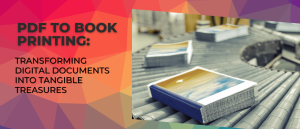Table of Contents
ToggleIn the constantly changing world of publishing, where digital formats often dominate, the art of custom book printing has emerged as a beacon of creativity and engagement.
While electronic books offer convenience, there’s an undeniable allure to the tangible, personalized experience that a custom-printed book provides.
Custom book printing goes beyond mere words on paper; it’s a journey that transforms stories, ideas, and knowledge into physical works of art. By tailoring every aspect of a book, from cover design to paper quality, fonts to illustrations, authors and publishers can craft a unique and immersive reading experience that captivates readers’ senses.
In this digital age, where screens vie for our attention, custom book printing rekindles our love affair with the printed word. It engages readers on a tactile and emotional level, creating a connection that lingers long after the final page is turned.
Join us as we swim deep into the world of custom book printing, exploring how it redefines reader engagement and breathes new life into the timeless tradition of storytelling.
Reader-Centric Custom Book Design:
Reader-centric custom book design is a pivotal element in the world of book publishing, emphasizing the importance of tailoring the visual and structural aspects of a book to create an engaging and enjoyable reading experience.
Unlike generic, one-size-fits-all book layouts, reader-centric design takes into account factors such as font choice, spacing, formatting, and overall aesthetics, all with the aim of enhancing readability and immersion.
It acknowledges that a well-designed book not only delivers content but also communicates the author’s voice and intent effectively. By incorporating elements that resonate with the target audience and reflect the book’s genre and theme, custom book design fosters a deeper connection between the reader and the material.
It goes beyond mere text and images, transforming a book into a work of art that captivates and sustains the reader’s attention, making it an integral part of the storytelling process.
In today’s competitive literary landscape, reader-centric custom book design stands as a powerful tool to set a publication apart, leaving a lasting impression on its audience.
Fonts and Typography:
Fonts and typography play a crucial role in visual communication and design, impacting not only aesthetics but also the readability and overall impact of written content. In the realm of fonts, each typeface carries a unique personality and conveys a distinct tone.
Serif fonts, with their elegant and traditional appearance, often find their place in formal documents and print media. In contrast, sans-serif fonts are favored for their modern, clean lines and digital-friendly legibility. Typography, on the other hand, encompasses the art of arranging type to make language visible.
This artistry involves selecting appropriate fonts, sizing, spacing, and alignment to create a harmonious and visually pleasing layout. In the realm of book design, the choice of fonts and typography directly influences the reader’s experience.
The right selection can enhance readability, evoke emotions, and convey the intended message effectively. It’s a delicate balance that authors, designers, and publishers carefully consider to create a truly immersive and enjoyable reading journey.
Custom Book Printing vs. Standard Publishing:
Custom book printing and standard publishing represent two distinct approaches to bringing books to the market, each with its own set of advantages and considerations.
Choosing between custom book printing and standard publishing depends on an author’s goals and priorities.
Custom printing is ideal for those who seek full creative control and are willing to invest in producing a unique, customized book.
Standard publishing offers wider distribution and support but may entail compromising on certain creative aspects. Ultimately, the decision comes down to the author’s vision, budget, and publishing objectives.
Custom Book Printing:
Custom book printing is a personalized and flexible approach to publishing. With custom printing, authors and publishers have full control over every aspect of the book, from the cover design to paper quality and formatting.
This approach allows for unique and visually striking books tailored to specific preferences and target audiences. Authors can choose niche printing options, such as limited editions, specialty paper, and unique binding, to create a one-of-a-kind reading experience.
Custom book printing is often favored by authors looking to maintain creative control and produce high-quality, aesthetically pleasing books.
Standard Publishing:
Standard publishing, on the other hand, follows more traditional industry practices. It involves submitting a manuscript to a publishing house, which then takes on the responsibility of editing, designing, printing, and distributing the book.
While standard publishing may offer broader market reach and the possibility of advances and royalties, it typically involves less author control over design and content decisions.
The Resurgence of Print in a Digital World:
In an era overwhelmingly dominated by digital technology, there has been a remarkable resurgence of interest in print media. This rekindling of appreciation for physical books, magazines, and other print materials is a testament to the enduring charm of the tangible written word.
While digital platforms offer convenience and accessibility, they lack the sensory experience that print provides. The act of holding a book, flipping through its pages, and even the scent of the paper contributes to a deeper, more immersive connection with the content.
Print media also boasts a timeless quality; it doesn’t rely on batteries or screens, making it enduring and reliable. Furthermore, in an age where screen fatigue is prevalent, print offers a welcome respite, allowing readers to disconnect from the constant barrage of digital information.
This resurgence underscores the idea that, in the digital world, print media remains not just relevant but indispensable for those seeking a richer, more meaningful reading experience.
The Role of Custom Printing in Storytelling:
The role of custom printing in storytelling is defined precisely below:
1. Visual Storytelling:
Custom printing allows for unique cover designs and formatting choices that visually represent the story’s themes, setting the tone for the reader.
2. Enhanced Engagement:
Personalized details, such as font selection and layout, can draw readers deeper into the narrative, making it a more immersive experience.
3. Character Development:
Custom printing enables the inclusion of custom illustrations or character sketches, providing readers with visual insights into the story’s protagonists.
4. Setting the Mood:
The choice of paper type, color schemes, and printing methods can evoke specific atmospheres or eras, enhancing the storytelling experience.
5. Limited Editions:
Custom printing can be used to create limited edition runs, adding a sense of exclusivity and collectability to a story.
6. Tactile Connection:
The physicality of a custom-printed book fosters a tactile connection, making the story more tangible and memorable.
7. Unique Formats:
Custom printing allows for unconventional book sizes and formats that can mirror the story’s uniqueness or creativity.
8. Personal Touch:
Authors and publishers can include personal notes, dedications, or even hand-signed copies, creating a direct, personal link between the creator and the reader.
9. Reflecting Themes:
Custom printing choices can reflect the story’s themes, whether it’s using recycled paper for an eco-conscious narrative or embossing for a tale of elegance and sophistication.
10. Commemorating Milestones:
Custom printing is often employed for special occasions, such as anniversaries or commemorative editions, to celebrate the lasting impact of a story.
The Emotional Connection of Books and Readers:
Books hold a unique power to forge emotional connections between readers and the written word. They are vessels for stories, ideas, and experiences that can resonate deeply with individuals.
The act of reading, whether through the pages of a physical book or the screen of a digital device, often elicits profound emotions—joy, empathy, sadness, and inspiration.
Characters become companions, and their journeys mirror our own, fostering empathy and understanding. The smell and texture of a book, the act of flipping pages, all contribute to a multisensory experience that imprints the story in our memories.
This emotional connection transcends time and technology, making books cherished conduits of human expression and empathy.














